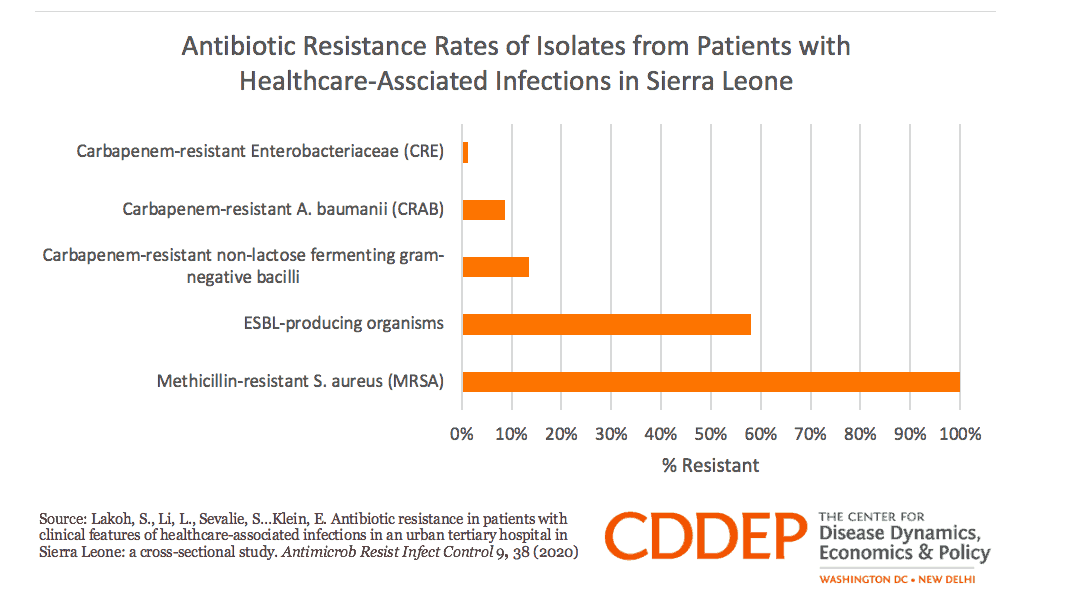March 02, 2020

Childhood vaccination linked to higher schooling attainment among adults in India. Researchers from CDDEP, Sam Houston State University, Johns Hopkins, and Harvard University found that India’s Universal Immunisation Programme (UIP) was tied to higher schooling attainment among adults in India. The researchers matched district-level data on the implementation of UIP between 1985 and 1990 with data from the National Family Health Survey of India, 2015–2016 to compare schooling attainment among individuals born before (control), during or after (intervention) the implementation of UIP. The study found that India’s UIP was associated with 0.2-0.3 additional schooling grades among adults. [Social Science and Medicine]
Resistant isolates common among hospitalized patients with HAIs in Sierra Leone. In a cross-sectional study co-authored by CDDEP Senior Fellow Eili Klein, researchers identified a high prevalence of resistance in extended-spectrum beta-lactamase (ESBL)-producing organisms among patients with clinical features of healthcare-associated infections (HAIs) at an urban tertiary hospital in Sierra Leone. Resistance rates were highest among all ESBL-producing organisms (58 percent), followed by carbapenem-resistant non-lactose fermenting gram-negative bacilli (13.4 percent), carbapenem-resistant Acinetobacter baumannii (8.7 percent), and carbapenem-resistant Enterobacteriaceae (CRE) (1.3 percent). All Staphylococcus aureus isolates in the study were resistant to methicillin. [Antimicrobial Resistance and Infection Control, CDDEP]

Prescribing macrolide antibiotics during pregnancy tied to major malformations. In a study of 104,605 children in the United Kingdom, researchers found that prescribing macrolide antibiotics during the first trimester of pregnancy led to an increased risk of major malformations compared to penicillin antibiotics (adjusted RR: 1.55). Macrolide prescribing at any time during pregnancy was linked to an increased risk of genital malformations (aRR: 1.58), and erythromycin prescribing during the first trimester was associated with an increased risk of any major malformation in children (aRR: 1.50). [BMJ]
US flu vaccine successful in reducing influenza-related medical visits this season. Researchers analyzed data from the U.S. Influenza Vaccine Effectiveness Network and estimated that the interim effectiveness of the influenza vaccine for the 2019-2020 season is 45 percent. The adjusted vaccine effectiveness among 4,112 individuals at least 6 months of age with acute respiratory illness was 45 percent against influenza A and B, 50 percent against influenza B/Victoria viruses, and 37 percent against A(H1N1)pdm09. The effectiveness of the flu vaccine was even higher among patients 6 months to 17 years old, providing 55 percent protection against influenza. The effectiveness of previous flu vaccines has ranged from 40-60 percent, and researchers note that this season’s vaccine has been especially successful in reducing flu-related medical visits. [CDC MMWR]
COVID-19 continues to spread as clinical trials for antiviral treatments emerge. The US Centers for Disease Control and Prevention (CDC) reported the first two COVID-19 deaths in the United States, as community spread of the virus continues. As of March 2, 2020, there have been nearly 89,000 cases of COVID-19 and 3,043 deaths reported across 65 countries worldwide. South Korea (4,212 cases), Italy (1,689 cases), and Iran (978 cases) currently have the largest outbreaks of COVID-19, preceded by China. At the same time, the US National Institutes of Health is launching the first US trial for remdesivir, an experimental antiviral drug previously used to treat Ebola, among hospitalized COVID-19 patients. [CDC, WHO, NIH, CNN]
Trends in resistant E. coli have decreased among humans and animals in France. A group of researchers in France analyzed isolates from antimicrobial resistance (AMR) surveillance systems and identified a significant reduction in AMR among Escherichia coli isolates from food-producing animals and pets as well as a slight decrease in resistance among E. coli isolates from humans between 2014 and 2017. The study found an equivalent proportion of resistance among isolates collected from humans and animals, including E. coli resistance to third-generation cephalosporins and fluoroquinolones, which tended to fall below 10 percent. [Journal of Antimicrobial Chemotherapy]
Anti-MRSA therapy linked to increased risk of death and infection among hospitalized pneumonia patients. Researchers in Utah conducted a retrospective cohort study of 88,605 Veterans Health Administration patients hospitalized for community-onset pneumonia between 2008 and 2013 and found that empirical anti-methicillin-resistant Staphylococcus aureus (MRSA) therapy plus standard antibiotic therapy was linked to an increased risk of death and infection compared to standard antibiotic therapy alone. The study found that empirical anti-MRSA therapy used in addition to standard therapy was associated with an increased risk of 30-day mortality, kidney injury, secondary Clostridioides difficile infection, vancomycin-resistant Enterococcus spp infection, and secondary gram-negative rod infection compared to standard therapy alone (adjusted RR: 1.4-1.6). [JAMA Internal Medicine]
Contact isolation ineffective at controlling spread of ESBL-E in non-critical care wards. In a cluster-randomized crossover trial across 20 non-critical care wards in European hospitals, researchers found that contact isolation had no benefit in controlling the spread of extended-spectrum β-lactamase-producing Enterobacterales (ESBL-E). The incidence density of ward-acquired ESBL-E was not significantly different during periods of contact isolation versus periods of standard precautions only (6.0 vs. 6.1 events per 1000 patient-days at risk, p=0·9710). [The Lancet Infectious Diseases]
Report says the world is failing to provide children with a healthy future. A commission of global child health experts convened by the World Health Organization (WHO), UNICEF, and The Lancet released a report titled, “A Future for the World’s Children?”, which states that all countries are failing to protect their children’s health, environment, and futures. The report notes ecological degradation, climate change, and exploitative marketing of unhealthy food and drinks, alcohol, and tobacco as threats to our children’s future. While the world’s poorest countries should take action to ensure their children lead healthy lives, the report suggests that high-income countries must reduce their carbon dioxide emissions in an effort to protect all children. [The Lancet, WHO]











